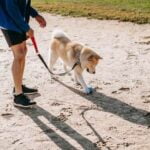Training a baby dog is an essential aspect of responsible pet ownership. In this article, we will explore the importance of training a baby dog and provide practical tips on how to effectively train and socialize your furry bundle of joy.
Understanding the basics of a dog’s development, building a strong bond, and using positive reinforcement are key components in successful training. We will also delve into common challenges that may arise during the training process and offer solutions to overcome them.
As a pet owner, it is important to start training your baby dog from an early age to ensure they grow into well-behaved and socialized adult dogs. By understanding the developmental stages of a baby dog and utilizing effective training techniques, you can set your furry companion up for a lifetime of good behavior and positive interactions with other animals and people.
In this article, we will cover various aspects of training a baby dog, including basic commands, crate training, socialization, consistency, patience, and troubleshooting common challenges that may arise. With the right guidance and tools, you can build a strong foundation for your baby dog’s behavioral development and create a happy and harmonious relationship between you and your four-legged friend.
Understanding the Basics
When training a baby dog, it is essential to understand the basics of their age and development. Just like human babies, baby dogs go through different stages of development that can impact their ability to learn and understand commands. Understanding these stages can help you tailor your training methods to suit your baby dog’s specific needs.
Stages of Development
- Newborn – 2 weeks: At this stage, baby dogs are completely dependent on their mother for nourishment and warmth. They are unable to see or hear properly, and their main focus is on nursing and sleeping.
- 2 – 4 weeks: Baby dogs begin to open their eyes and ears, allowing them to start exploring their environment. They also start to interact with littermates and show early signs of behavior such as playfulness.
- 4 – 12 weeks: This is a crucial stage for socialization in baby dogs. They start learning from their surroundings, including humans and other animals. This period is also when they start teething, which can impact their chewing behaviors.
Training According to Age
It is important to adjust your training methods based on your baby dog’s age and developmental stage. For example, very young puppies may have a shorter attention span and require more frequent breaks during training sessions. In contrast, older puppies may have better control over their bladder and bowels, making it easier for them to learn crate training.
Understanding the basics of age and development is key when considering how to train baby dog effectively. Adjusting your training methods according to your baby dog’s specific needs can set them up for a lifetime of good behavior.
Building a Bond
Building a strong bond with your baby dog is essential for successful training. This bond forms the foundation for effective communication and trust between you and your furry companion. In order to establish this bond, it is important to spend quality time with your dog, engage in interactive play, and provide plenty of positive reinforcement.
One of the key elements in building a strong bond with your baby dog is through regular training sessions. These sessions not only help reinforce good behavior, but also create a sense of teamwork between you and your dog. By working together on commands and activities, you are strengthening the bond and developing a deeper understanding of each other.
In addition to training sessions, spending quality time bonding with your baby dog through grooming, exercise, and simply being present can have a huge impact on their behavior and development. Through these activities, you are showing your dog that they can trust you and rely on you for love, care, and guidance.
This strong foundation will make it easier to teach them how to behave well in various situations as they grow. As you work on building this bond with your baby dog through training and bonding activities, remember to be patient and consistent – this will help them learn faster while strengthening the connection between you.
Basic Commands
Training a baby dog to understand and follow basic commands is essential in developing good behavior and obedience. Teaching these commands at an early age sets the foundation for a well-behaved adult dog. The key to successfully training a baby dog to learn these commands lies in patience, consistency, and positive reinforcement.
First, it’s important to understand that baby dogs have short attention spans and may not grasp the commands right away. This is why patience is crucial when teaching them to sit, stay, come, and leave it. Keep training sessions short and frequent to avoid overwhelming the puppy. Use gentle guidance and repetition to reinforce each command until the puppy understands what is expected.
Positive reinforcement plays a significant role in how to train a baby dog. Using treats as rewards for obeying commands can motivate the puppy to learn quickly and eagerly. Pairing treats with verbal praise can further reinforce good behavior. However, it’s essential to strike a balance between using treats as a reward and not relying on them solely for obedience, as you want your puppy to eventually respond to commands without needing a treat every time.
In addition to positive reinforcement, consistency is key when teaching basic commands to a baby dog. Use the same words or hand signals each time you give a command so that the puppy begins associating the word or action with the desired behavior. Consistency in training methods helps prevent confusion for the puppy and facilitates faster learning of basic commands such as sit, stay, come, and leave it.
Positive Reinforcement
Choosing the Right Treats
When it comes to using treats for training a baby dog, it’s important to choose the right kind. Look for small, soft treats that are easy for your puppy to chew and swallow quickly. You can also use their regular kibble as a treat if they find it rewarding. It’s essential to be mindful of the calorie content of the treats and adjust your dog’s meals accordingly to prevent overfeeding.
Using Praise Effectively
In addition to using treats, praise is a powerful tool in training your baby dog. Dogs thrive on positive reinforcement, so make sure to shower them with praise when they successfully follow a command. Use an upbeat tone of voice and make eye contact with your puppy as you praise them. This will reinforce the behavior and strengthen the bond between you and your pet.
Combining Treats and Praise
For maximum effectiveness, combine treats and praise when training your baby dog. When your puppy does something right, immediately give them a treat followed by verbal praise and physical affection such as petting or belly rubs. This dual reinforcement will help solidify their understanding of what behavior is being rewarded, making it more likely that they’ll repeat it in the future.
Positive reinforcement through the use of treats and praise can help inculcate good behavior in your baby dog while also strengthening the bond between you two. Using this method consistently and patiently will certainly yield positive results in how to train baby dogs effectively throughout their development stages.
Crate Training
Choosing the Right Crate
When it comes to crate training, one of the most crucial decisions is selecting the right crate for your baby dog. The crate should be large enough for the dog to stand up, turn around, and lie down comfortably. It should also be sturdy and well-ventilated to ensure the dog’s safety.
Introducing the Crate
To ensure that your baby dog sees the crate as a positive space, it’s essential to introduce it gradually. Start by leaving the crate door open so that your puppy can explore it at their own pace. You can place some treats or toys inside to entice them to go in.
Using the Crate Effectively
Once your baby dog is comfortable with being in the crate, you can start using it for short periods when you cannot directly supervise them. Remember to make their time in the crate positive by providing treats or toys and never using it as a form of punishment. Gradually increase the time they spend in the crate to help them get used to being confined when necessary.
By following these steps and taking into account your baby dog’s comfort and safety, you can effectively crate train them. Remember that consistency, patience, and positive reinforcement are key elements in successfully establishing the crate as a safe space for your furry friend.
Socialization
To successfully socialize a baby dog, it is important to expose them to various environments, sounds, and experiences. This can include introducing them to different types of people (such as children, adults, and seniors) as well as other animals (such as cats and other dogs). It’s also crucial to ensure these interactions are positive and not traumatic in any way.
One effective way to socialize a baby dog is through puppy classes or playdates with other vaccinated and well-behaved dogs. These interactions provide opportunities for your puppy to learn appropriate play behaviors while being supervised by both you and the other dog owners.
It’s important to remember that the experiences your puppy has during this critical stage will shape their behavior in the future. Therefore, providing them with positive interactions and experiences is key to raising a well-adjusted adult dog.
| Training Method | Description |
|---|---|
| Puppy classes | This provides an opportunity for puppies to socialize with each other in a controlled environment while learning basic obedience commands. |
| Playdates | Setting up playdates with other vaccinated and well-behaved dogs allows puppies to learn appropriate play behaviors under supervision. |
Consistency and Patience
When it comes to training a baby dog, consistency and patience are crucial elements for success. Just like human babies, baby dogs require repetition and a predictable routine in order to understand and retain your training efforts. By consistently reinforcing desired behaviors and being patient with their learning process, you can set your baby dog up for a lifetime of good behavior.
Consistency in training means setting clear rules and boundaries for your baby dog and sticking to them at all times. For example, if you’re teaching your puppy not to jump on the furniture, it’s important that everyone in the household enforces this rule consistently. Inconsistencies can confuse your baby dog and make training more challenging.
Patience is also key when it comes to training a baby dog. Puppies have short attention spans and may not grasp commands immediately. It’s important to remain calm and patient during the training process, avoiding frustration or punishment when they don’t immediately respond as expected. Remember that all dogs learn at their own pace, so be patient and supportive as your baby dog works on mastering new skills.
In addition to being consistent with rules and patient with their progress, it’s important to show your baby dog plenty of love, praise, and positive reinforcement throughout the training process. This will help build a strong bond between you and your pet while also encouraging them to continue learning and following commands. With consistency, patience, and positive reinforcement, you’ll be well on your way to successfully training your baby dog.
Troubleshooting
Training a baby dog can be a rewarding experience, but it also comes with its fair share of challenges. From potty training to teaching basic commands, there are many obstacles that new puppy parents may face. However, with patience and consistency, these challenges can be overcome.
One common issue that many puppy parents encounter is biting or nipping. This behavior is natural for puppies as they explore the world around them, but it can become problematic if not addressed early on. One solution to this challenge is to redirect their attention to a toy or bone whenever they start to nip at your hands or feet. Additionally, yelping or saying “ouch” in a high-pitched tone can help them understand that their behavior is causing discomfort.
Another common challenge in training baby dogs is potty training. Accidents are bound to happen, but it’s important to remain patient and consistent in your approach. Establishing a routine for feeding and bathroom breaks can help your puppy understand when it’s time to go outside. It’s also crucial to praise and reward them when they do their business in the appropriate place, reinforcing positive behavior.
Separation anxiety is another common issue that many puppy parents face. Baby dogs can become anxious when left alone, leading to destructive behavior such as chewing furniture or excessive barking. To address this challenge, gradually accustom your puppy to being alone by leaving them alone for short periods and gradually increasing the time. Providing them with toys or treats before you leave can also help alleviate their anxiety.
Overall, understanding the common training challenges that come with raising a baby dog and implementing effective solutions can lead to a well-behaved and well-adjusted pet in the long run.
| Training Challenge | Solution |
|---|---|
| Biting or nipping | Redirect attention to toys or bones, yelping or saying “ouch” |
| Potty training | Establish routine for feeding and bathroom breaks; praise and reward positive behavior |
| Separation anxiety | Gradually accustom puppy to being alone; provide toys or treats before leaving |
Conclusion
In conclusion, training your baby dog is an essential part of setting them up for a lifetime of good behavior. By understanding the basics of age and development, building a strong bond, teaching basic commands, using positive reinforcement, and practicing consistency and patience, you can ensure that your puppy grows into a well-behaved adult dog.
It’s important to remember that training a baby dog takes time and effort, but the rewards of having a well-behaved companion are well worth it.
One of the most crucial aspects of training your baby dog is socialization. Introducing them to different people, animals, and environments from an early age can help prevent behavior issues in the future. Additionally, crate training provides them with a safe space they can retreat to when feeling anxious or overwhelmed.
It’s important to remember that every dog is unique and may have their own set of challenges when it comes to training. Patience, consistency, and seeking professional help when necessary are key in overcoming these challenges. By following these tips on how to train baby dogs, you can lay a solid foundation for a lifetime of good behavior and companionship with your furry friend.
Frequently Asked Questions
What Is the First Thing You Should Train Your Puppy?
The first thing you should train your puppy is their name. Use positive reinforcement, such as treats and praise, to help them associate their name with something good. This will set the foundation for further training.
How Do You Discipline a Baby Dog?
When disciplining a baby dog, it’s important to use positive reinforcement and consistency. Avoid using physical punishment as it can harm the trust between you and the puppy. Instead, focus on redirecting their behavior and rewarding good actions.
How Old Should a Puppy Be to Start Training?
It’s best to start training a puppy when they are around 8-10 weeks old. This is a good age for them to start learning basic commands and socialization skills. Keep training sessions short and positive to accommodate their short attention span.

Welcome to the blog! I am a professional dog trainer and have been working with dogs for many years. In this blog, I will be discussing various topics related to dog training, including tips, tricks, and advice. I hope you find this information helpful and informative. Thanks for reading!





